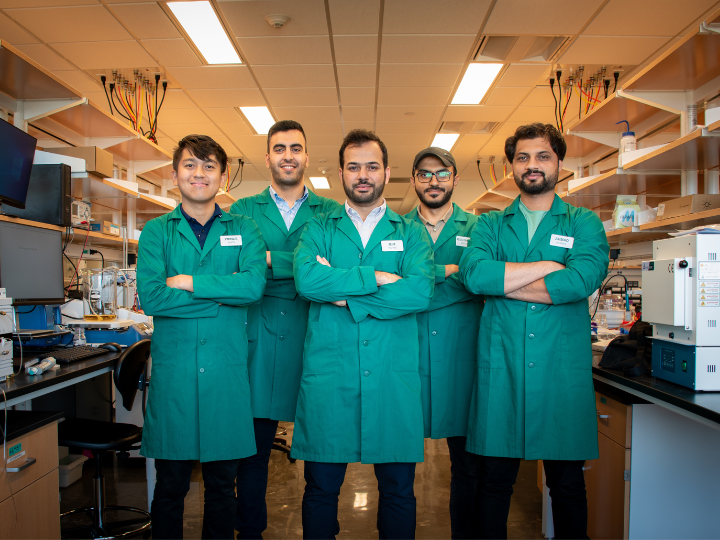As scientists around the world race against the clock to develop new strategies and technologies to combat climate change, a team of scientists at the University of Houston is looking into one possible way to reduce the amount of carbon dioxide in the environment: negative emissions technologies (NETs).
 Mim Rahimi, assistant professor (center) with his doctoral students (left to right) Prince Aleta, Mohsen Afshari, Abdelrahman Refaie and Ahmad Hassan. Image Credit: University of Houston
Mim Rahimi, assistant professor (center) with his doctoral students (left to right) Prince Aleta, Mohsen Afshari, Abdelrahman Refaie and Ahmad Hassan. Image Credit: University of Houston
A new NET called electrochemical direct ocean capture (eDOC), which aids the ocean in ridding itself of toxic carbon dioxide, is being developed by Mim Rahimi, Assistant Professor of Environmental Engineering at the University of Houston’s Cullen College of Engineering. A study published in the journal Energy & Environmental Science describes the concept in depth.
Electrochemical direct ocean capture amplifies the ocean’s ability to absorb carbon, sidestepping the expensive sorption process typical in many current strategies. The promise of eDOC is undeniable, but scaling it, optimizing costs and achieving peak efficiency remain challenges we are actively addressing.
Mim Rahimi, Assistant Professor, Environmental Engineering, Cullen College of Engineering, University of Houston
The bulk of the carbon dioxide emitted by the Earth is stored in the atmosphere and the terrestrial biosphere, but the great majority is found in the seas. The globe’s five oceans contain 38,000 gigatons of CO2, according to World Ocean Review.
Furthermore, according to United Nations climate scientists, oceans absorb 25% of all CO2 emissions and trap 90% of the excess heat created by those emissions, making them a critical buffer against climate change.
Rahimi and his colleagues are developing electrochemical tubes to extract dissolved inorganic carbon from synthetic seawater, thanks to a $250,000 funding from the US Department of Energy. The University of Houston’s Center for Carbon Management in Energy funded preliminary project studies.
The majority of current efforts to remove carbon dioxide from the ocean include sophisticated techniques such as electrolysis, which seek to convert dissolved inorganic carbon into gas, magnesium or calcium carbonates. However, due to the utilization of rare and expensive elements such as platinum and specific membranes that frequently clog, these procedures are energy-intensive and expensive.
The alternate technique developed by the researchers eliminates the requirement for such costly membranes. Instead, it uses an inexpensive and ecologically acceptable electrode material to alter the acidity of seawater. Not only does the technology promise to be more cost-effective, but it also promises to drastically minimize the environmental impact of traditional carbon removal activities.
While membrane-based systems showed promise, they come with challenges. We’re using electricity instead of thermal-based methods, and our current trajectory emphasizes systems without membranes for heightened efficiency.
Prince Aleta, Doctoral Student, University of Houston
One of the most significant advantages of this invention is its adaptability and scalability. The solution is simple to incorporate into current on-shore infrastructure, such as desalination facilities as well as off-shore places like as oil rigs.
Rahimi concluded, “While eDOC won’t single-handedly turn the tide on climate change, it enriches our mitigation toolkit. In this global challenge, every innovative approach becomes invaluable.”
Journal Reference:
Aleta, P., et al. (2023) Direct Ocean Capture: The Emergence of Electrochemical Processes for Oceanic Carbon Removal. Energy & Environmental Science. doi:10.1039/D3EE01471A